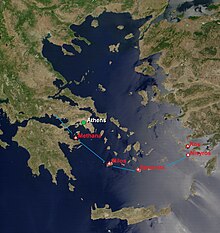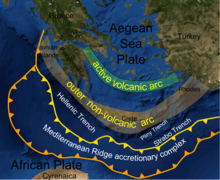geo.wikisort.org - Insel
Der Kykladenbogen ist ein vulkanischer Inselbogen im südlichen Ägäischen Meer. Er ist ca. 450 km lang, 20 bis 40 km breit und verläuft vom Isthmus von Korinth bis zur kleinasiatischen Bodrum-Halbinsel. Auf diesem Bogen liegen die griechischen Vulkaninseln Ägina, Methana (Halbinsel), Milos, Santorin, Nisyros, Strongyli (bei Nisyros), Gyali, Kos und Poros sowie der Unterwasservulkan Kolumbos und die kleinen, unbewohnten Christiana-Inseln, und die Vulkane Sousaki im Isthmus von Korinth und Akyarlar[1] auf der Bodrum-Halbinsel.


In einer Zone südlich von Kreta (Tiefseegraben) schiebt sich die Afrikanische Platte mit gegenwärtig 5 cm pro Jahr unter die Ägäische Platte, eine Teilplatte der Eurasischen Platte[2]. In Tiefen von ca. 150 bis 180 km wird das Mantelgestein oberhalb der unterschobenen Platte durch aus jener entweichende flüchtige Bestandteile (Kohlendioxid, Kristallgitterwasser, Halogene) geschmolzen. Durch diese dann in der Schmelze gelösten Gase bekommt das geschmolzene Gestein Auftrieb und steigt in einer bogenförmigen Zone ca. 120 km nördlich von Kreta in Form von Vulkanen wieder an die Erdoberfläche (vulkanische Produkte: Andesite, Dazite, Rhyolithe).
Literatur
- Volker Jacobshagen, Geologie von Griechenland (1986).
Einzelnachweise
- Akyarlar (Englisch) Volcanodiscovery.com. Abgerufen am 29. März 2020.
- David M. Pyle, John R. Elliott: Quantitative morphology, recent evolution, and future activity of the Kameni islands volcano, Santorini, Greece. In: Geosphere. Band 36, Nr. 2, 2006, S. 253–268.
На других языках
- [de] Kykladenbogen
[en] South Aegean Volcanic Arc
The South Aegean Volcanic Arc is a volcanic arc (chain of volcanoes) in the South Aegean Sea formed by plate tectonics. The prior cause was the subduction of the African plate beneath the Eurasian plate, raising the Aegean arc across what is now the north Aegean Sea. It was not yet the sea, nor an arc, or at least not the one it is today, nor was there a chain of volcanoes. In the Holocene the process of back-arc extension began, probably stimulated by pressure from the Arabian Plate compressing the region behind the arc. The extension deformed the region into its current configuration. First, the arc moved to the south and assumed its arcuate configuration. Second, the Aegean Sea opened behind the arc because the crust was thinned and weakened there. Third, magma broke through the thinned crust to form a second arc composed of a volcanic chain. And finally, the Aegean Sea Plate broke away from Eurasia in the new fault zone to the north.[it] Arco vulcanico dell'Egeo meridionale
L'arco vulcanico dell'Egeo meridionale è un arco vulcanico (catena di vulcani) nel Mar Egeo meridionale causato da fenomeni tettonici come conseguenza della subduzione della placca africana al di sotto della placca eurasiatica . L'Egeo meridionale è una delle regioni che si deformano più rapidamente della cintura montuosa himalayano-alpina . È lungo circa 450 km e largo da 20 a 40 km e va dall'istmo di Corinto sulla terraferma greca alla penisola di Bodrum sulla terraferma turca.[1] Costituisce la parte interna del cosiddetto Arco Ellenico (quella esterna è costituita da isole non vulcaniche), a sua volta delimitato dalla Fossa Ellenica, che contiene il punto più profondo del Mar Mediterraneo, l'Abisso Calipso.Другой контент может иметь иную лицензию. Перед использованием материалов сайта WikiSort.org внимательно изучите правила лицензирования конкретных элементов наполнения сайта.
WikiSort.org - проект по пересортировке и дополнению контента Википедии